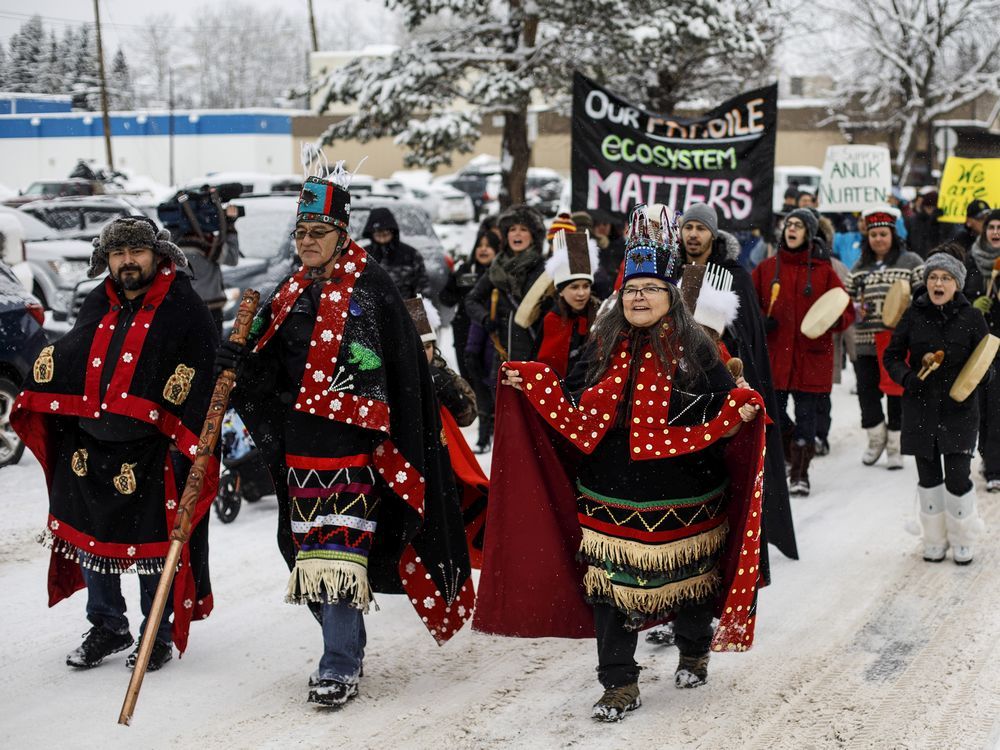Vaughn Palmer: Past NDP statements may have laid foundation for pipeline protests

Credit to Author: Hugh Dawson| Date: Tue, 11 Feb 2020 02:41:26 +0000
VICTORIA — The B.C. New Democrats cannot have been happy that the pipeline protest arrived at the front steps of the legislature in time to draw attention away from Tuesday’s speech from the throne.
Still, there was an element of justice in the NDP being confronted with the controversy as they were preparing to lay out their 2020 legislative agenda.
For the arguments being made by the Wet’suwet’en hereditary chiefs opposed to the Coastal GasLink natural gas pipeline are similar to arguments the New Democrats themselves made before they got into government.
The Wet’suwet’en hereditary chiefs — and their allies in mounting the protest at the legislature — say they, not elected chiefs and band councils, are the rightful custodians of the traditional territories of their people.
New Democrat Doug Donaldson, speaking for the then-Opposition, said much the same thing back in 2015.
“In the Wet’suwet’en governance system, the rightful aboriginal titleholders are the hereditary chiefs,” he told the legislature. “This is different from the Indian Act-created band council system. Band councils in Wet’suwet’en territory have a federally conferred governance role on reserve lands created by the Canadian government.”
Donaldson was speaking during debate on Pacific Northwest LNG, a multi-billion-dollar liquefied natural gas project being proposed for a site near Prince Rupert.
He went on to explain why the jurisdictional distinction between hereditary chiefs and elected band councils mattered.
The natural gas feeder pipeline for the project was crossing the territory of both the Wet’suwet’en and Gitxsan people.
But the chosen route was not across the reserve land overseen by the band councils. Rather, in the case of the Gitxsan, “it crosses hereditary house group territory subject to aboriginal title.”
Wet’suwet’en hereditary chiefs opposed to the Coastal GasLink pipeline hold a press conference in Smithers, B.C., on Jan. 7, 2020.
Donaldson knew whereof he spoke. His Stikine constituency includes some of the territory in question, and such was his relationship with the Gitxsan that he was adopted and given an honorary name by one of their houses.
As for the Wet’suwet’en, “no hereditary chiefs have said yes to pipelines in their territories. In fact, they’ve said no to LNG-related gas pipelines across their traditional territories.”
Donaldson was speaking in reference to both the Pacific Northwest LNG project and the LNG Canada project that was proposed for Kitimat.
Since then, some Wet’suwet’en leaders, both elected and hereditary, have supported the Kitimat project and construction is underway.
But several hereditary chiefs of the Wet’suwet’en, being opposed to the project, have established an encampment in the path of the Coastal GasLink pipeline that would supply natural gas to the Kitimat terminal.
In outlining the difference between hereditary chiefs and elected band councils back in 2015, Donaldson lamented that the then-Liberal government “has difficulty understanding or recognizing” the distinction.
But his own party would appear to be having similar difficulties now that it is in government.
While the New Democrats opposed Pacific Northwest LNG (which died soon after they took office), they endorsed the Kitimat project and approved $6 billion in tax and regulatory relief to make sure it went ahead.
Every time Premier John Horgan is asked about the standoff, he emphasizes that the project is supported by the elected leadership of all 20 First Nations along the route.
Protestors block road access to the Port of Vancouver Saturday, February 8, 2020.
Ironically, one of the hereditary chiefs who was on the same side as the New Democrats in opposing Pacific Northwest LNG, Namoks (John Ridsdale), is now a leader in opposing the Coastal GasLink pipeline.
Horgan said recently that he does not believe the hereditary chiefs have the power to block the project.
Still, he says his government remains committed to “dialogue” with the hereditary leadership, although he himself refuses to meet with them while they are defying court injunctions.
Despite NDP efforts, the standoff continues. The RCMP are now proceeding to enforce the latest injunction against further blockage of the pipeline.
As for Donaldson, he is now the cabinet minister with responsibility for forests, lands, natural resources and rural development, which impacts some of the land-use issues around the pipeline.
He has also tried to remain on a good footing with the hereditary chiefs. Just before police moved in to begin enforcing the initial injunction last year, Donaldson paid a visit to the encampment.
When challenged as to the reasons for his visit, he replied, “The purpose today is to support and recognize that the hereditary chiefs have a responsibility for stewardship of the land.”
He professed to be “aware that the laws of Canada must be upheld and court injunctions must be followed,” while adding that in his view, “two systems of law,” one Indigenous, one Canadian “are colliding.”
More to the point was the comment made at about the same time by his NDP colleague, Jennifer Rice.
“It’s important to know that Indigenous people have Indigenous laws that go back thousands of years,” she wrote on social media. “The elected band council system is a colonial construct with the historic intention of annihilating Canada’s First Peoples.”
Donaldson and Rice, one a minister, the other a parliamentary secretary, are the only two elected New Democrats from the region.
I’ve not noticed them disavowing the comments reported here — comments in sympathy with the things the hereditary chiefs themselves have been saying about their jurisdiction and laws.
While the chiefs and their allies have their own reasons for opposing the pipeline, they might also feel that they were encouraged in their intransigence by the words spoken by the New Democrats themselves.